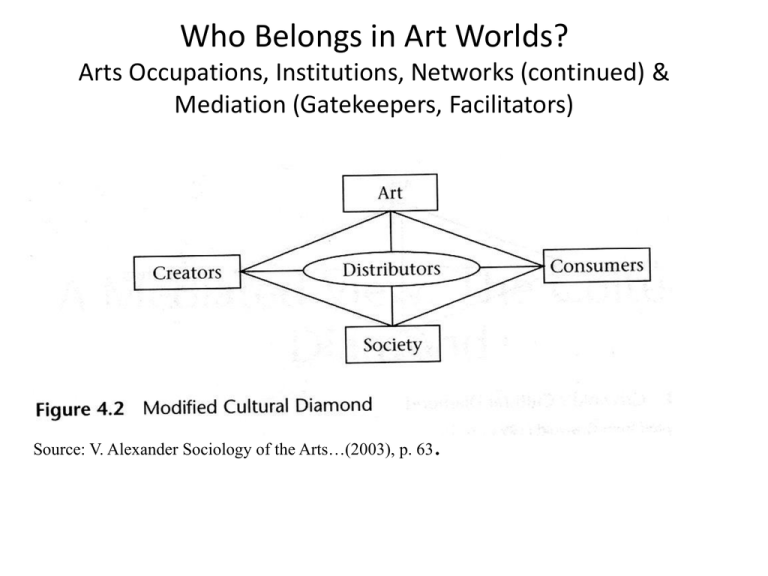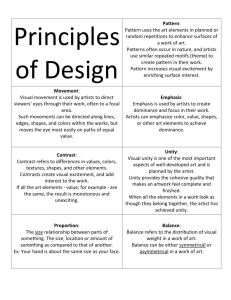3CMNS488-theories of art worlds
advertisement

Who Belongs in Art Worlds? Arts Occupations, Institutions, Networks (continued) & Mediation (Gatekeepers, Facilitators) Source: V. Alexander Sociology of the Arts…(2003), p. 63 . Today’s Class Session 1. Theories of Who Belongs in Art Worlds &(J.Marontate) 2. Presentations & Discussion of Readings 3. Guest Presentation on Research Resources by Sylvia Roberts 4. Finalizing student presentation dates & reading choices Who Belongs in Art Worlds? Arts Occupations, Institutions, Networks (continued) & Mediation (Gatekeepers, Facilitators) Source: V. Alexander Sociology of the Arts…(2003), p. 63 . Participants in art worlds -- Creators/artists art Audiences/publics/consumers Mediators Who Belongs to Art Worlds? c. Life Drawing Class, Bocour Paintmaking Studio NYC, c. 1942 Recall Overview: Internal vs. External Approaches • Internal (Humanist-aesthetics, history of the arts, critics, etc.) – art=mystery, spontaneous creation of isolated genius – importance of “aura” of individual artist for value of art work – timeless, enduring quality of beauty, perfection • External (Sociological--& cultural studies) – Art=social production (and reproduction) – importance of social networks for creation of belief in the arts – values change in different social & historic contexts Theories about changes in ideas about what art represents over time (J. Jurt) – rendering of “reality” (nature), mimesis, imitatio – as world view in a specific place & time – as product of solitary genius (Renaissance) – Artists’ vision (19th romanticism) – made by “system” of production & reception – Socio-political processes (symbolic & material) Who creates the ‘creator’? (Bourdieu) • “Unit of analysis” in art studies often wrong-– should not study “apparent” producers (painter, writer, actors etc.) but processes (art, artist part of broader field of relationships) • ideology of creation conceals exploitation by market forces • art trader or impressario =symbolic banker who creates belief in the arts by creating belief in the economic (and moral?) value of art Various criteria used in classifying art & artists, including: • Position of artist in “field of production” – Socio-political, economic position – “aura” of the artist (authenticity) -School of Frankfort, Walter Benjamin-- “Work of Art in the Age of Mechanical Reproduction”) • Features of the specific ‘field’ • Qualities/characteristics of the artwork – artistic category (genre, style etc.) • characteristics of the audience/public (notion of consecration) – “highbrow/lowbrow” tastes (Levine--The emergence of a cultural hierarchy in America) – SES – size Howard Becker’s Art Worlds • Arts worlds include all the people involved in art-making • Cooperative links through shared conventions • Study how participants “draw lines” and what art worlds do http://home.earthlink.net/~hsbecker/ • Types • Integrated professionals • Mavericks • Folk artists • Naïve artists • Classification according to how they fit in art worlds (degree of integration, consensus about the ‘rules of the game’, degree of standardization, and in some cases– like folk art-- «uses») What do art worlds do together? • Develop shared practices related to creation & communication (ex. musical notation systems) • Mobilize resources (material resources, training personnel, networks, organizations) • Develop Systems & Forms of recognition, mediation, reception (gatekeeping, patronage, publics) Presentations of Readings • Pavan Thind – Van Laar, T. and L. Diepeveen, 1997 "The Function of Artists in Society: Starving Celebrities and Other Myths", Active Sights. Art as social interaction., London, Mayfield: 51-69 • Pietro Sammarco – Becker, H. 1992 "Integrated Professionals, Mavericks, Folk Artists and Naive Artists" Art Worlds. Berkley: U. Calif. Press: 226-272. • Eliza Nguyen – Zolberg, Vera. 1990 “The Art Object as Social Process”. Constructing a Sociology of the Arts. Cambridge University Press: 79-102. • Madelynn Festing – Bennett, Andy. 2005 “Consolidating the Music Scenes Perspective” Poetics 21:223-234. Different types of artists/artworlds (Becker) • Types – – – – Integrated professionals Mavericks Folk artists Naïve artists • Classification according to how they fit in art worlds (degree of integration, consensus about the ‘rules of the game’, degree of standardization, and in some cases– like folk art-- «uses») Ranking Artists/Art Worlds (Becker’s 4 types) • according to different ways of working & career patterns • 1. integrated professionals – fit with accepted conventions & canons held by organizations – well-trained --technical skills, shared traditions 2.Mavericks • innovative rebels against “system” • begin as conventional “novices” but deliberately violate norms of art world • techniques for success-develop alternate systems for distribution • do not totally lose touch with world of their medium Kopyright Liberation Front’s Bill Drummond at the “Brit Awards”, 1993 3. Folk Art • link with community practices – ex. Duck decoys, quilts, chain-gang songs, Christmas pagents • art serves needs, part of daily activities • follows aesthetic conventions, using established procedures (ex. Sorting scraps by colour) • often part of well-organized community, with informal training 4. Naïve Art • aka. “primitive” naïve, grassroots • indiosynmcratic – ex. James Hampton, Throne of the Third Heaven of the national Millenium General Assembly – ex. Art of children and the insane • outsiders – N.S. artist Maud Lewis, Henri Rousseau, Grandma Moses Van Laar and Diepeveen on “The function of Artists in Society” – Another typology – Five roles: • • • • • Skilled worker Intellectual Entrepreneur Social critic Social healer – Other dimensions • Ex. Wittkower “Under the Sign of Saturn” – Transformation from craftsperson to brooding geniuss – Later to status of intellectual in humanistic profession F. De Goya. Saturn devouring his son, c. 1821 Conceptual & practical problems in studying artists & artistic careers • Establishing criteria for locating, identifiying artists • “Irrationality” of choices (P-M. Menger) – Ex. Choosing poorer pay for more prestigious roles as an actor • In modern times -- clash between notions of – career (regularities, patterns ) – artistic recognition (singularities, unique, break with past) – The ‘triple game’ of contemporary art (transgressions of boundaries of what is art , rejection by public, integration by arts professionals)— (Nathalie Heinich) Changing views about values of art can lead to changes in the status of the artist, artwork & the social institutions & publics that support them – Beaune Altarpiece – PBS jazz series by Ken Burns – Examples of establishing “cannons” through testimony of “experts” (ex. critics, “stars”, fans) and changing shape of artforms Unique artists, unique art works (individual) vs. social construction of art/artists (Zolberg) • Example: Problem of Multiples – negotiating artistic values in context of new technologies – new ways of thinking about connections between the artwork and the “aura” of the artist – Walter Benjamin-- “work of art in the age of mechanical reproduction” Research Resources for Studying Art Worlds • Guest Presentation by Sylvia Roberts, SFU Librarian (Communication and Contemporary Arts) Planning Short Assignments and Class Presentations • Discussion of reading assignments and ideas for topics for case studies






